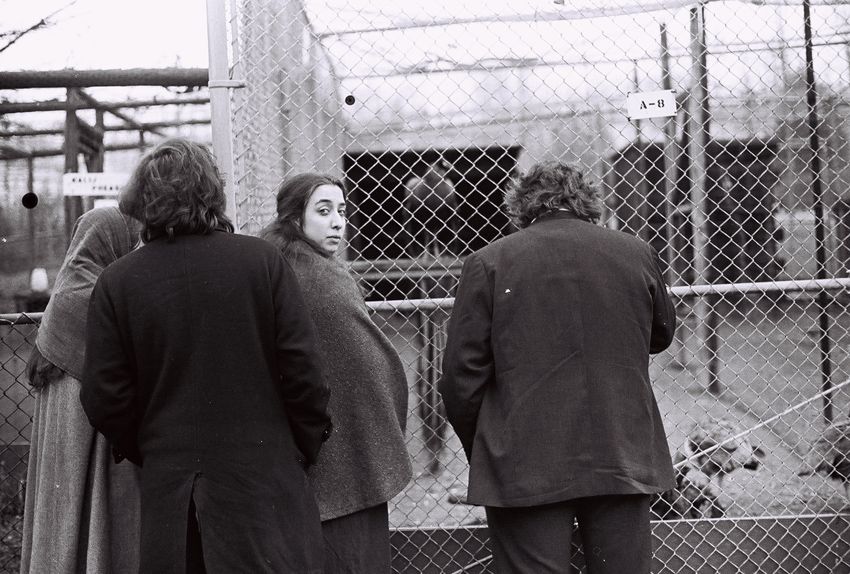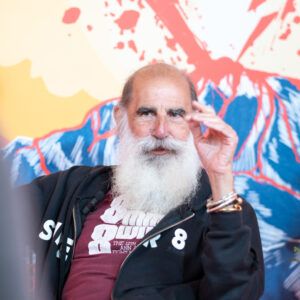- Sombras extravagantes, created and directed by Ariadna Solera and Álex Pena Morado, is one of the freshest and funniest podcasts on experimental and auteur cinema one can find: with depth and enthusiasm, they have been dedicating entire programmes to different events and creators. Information, criticism and a touch of gossip when appropriate: that is their hallmark. Today Sombras extravagantes gives us the impressions of their close encounter with Amy Halpern.

The truth is that at first we had never heard of her. We hadn’t seen any of her films, but you get used to that and even seek it out. An interest in experimental cinema involves both an aesthetic experience and a kind of addiction to that feeling of constant discovery—of new names and new titles, but above all new ways of seeing things. Nor did we know what specific era she belonged to, as part of a group or an aesthetic trend, but that’s not odd, either. Even if you know the films, sometimes it’s hard to sort out the shifting dates, link them to one another, or guess relationships that aren’t always obvious. Sometimes what we have found is that on seeing a filmmaker’s film for the first time we’re unable to know if it is a specific experiment or part of a more extensive (personal or collective) project. Actually, we weren’t even sure we had read her name before, and that was weird; not because neither of us is a great expert in the history of experimental cinema, but because in a relatively small world such as this as you memorise the names of the people responsible for the films you like. You also learn that they all knew each other through one way or another: these were a couple, those others studied together and later set up a commune, those met at the Filmmaker’s Coop and the others over there at a festival and now they work in the same laboratory. In a moment that’s difficult to specify, that feeling of discovery gets transformed. Films stop appearing out of nowhere. Instead, you seek them out by following a map that’s beginning to be drawn by everything you’ve seen up to that point.
When Amy Halpern visited Barcelona in early 2020, she appeared from outside our maps. We didn’t know who she was, much less what to expect from her films. Nor did we know that it would be the last time in months that we would set foot in a cinema. A week later, when we recorded the podcast we dedicated to her, we were talking about the possibility of seeing her again that same year, 2020, here in (S8). It was to be two years later, but here we are! Since then we have had time to think a lot about those three or four days. In the first image that comes to mind, Amy is dashing from one side of the table to the other on a bar’s terrace, looking for the frame to shoot a portrait of Ariadna while Alex is holding a sheet of paper to reflect the sunlight on the screen at the right angle. A couple of days later in a workshop on “guerrilla lighting”, she would explain to us all the tricks she had been inventing over the years of work as an electrician in industrial cinema, but above all the importance of light in her way of filming. To highlight a specific feature of a face, it is sufficient to reflect the light on it with white paper and perhaps darken the other side with black card. To get a small reflection in the pupils, a small flex is enough, although an extension cord has to be improvised to hang it with insulating tape from a wall. To do so, Amy had to stand on tiptoe on a wobbly chair, standing only on one foot while she was pulling some tool or other out of her belt with one hand.
For us it was a moment of tension that gave us just enough time to imagine five or six tragic endings to the scene. For Amy Halpern, it was a routine movement most probably repeated hundreds of times in the dozens of shoots she has worked on. Perhaps that’s what makes her films special: they are made by a person who works in cinema, who is not just an auteur but someone who performs a specific function in the process of creating the films that are later signed as authored by others. Hers are therefore experiments that are closely related to this work for others. Amy Halpern understands experimental cinema as a practice and not as a genre delimited by more-or-less defined aesthetic codes, the use of one medium or another, a style of montage or a duration. That is, it is a practice that involves actively experimenting with a subject, which is cinema, in order to understand the limits of its language. Like a chef trying out a new ingredient to know what to combine it with or a carpenter cutting a kind of wood for the first time to understand its qualities, Amy Halpern’s films usually focus on very specific processes of cinematographic material to understand their possibilities.
Of course, Amy Halpern didn’t just appear out of nowhere. Shortly after that meeting with her, we were reading a book about the early years of the Binghamton film studies programme, and Amy Halpern was there. We read about the influence of Larry Gottheim and Ken Jacobs, about the visits by Ernie Gehr, Peter Kubelka and the shooting of We Can’t Go Home Again by Nicholas Ray, and Amy Halpern was there. We looked back at the credits to the films of Charles Burnett and to The Decay of Fiction, Pat O’Neill’s masterpiece, and Amy Halpern was there. We researched the history of experimental cinema on the West Coast of the United States, often eclipsed by the importance of the New York scene linked to the Filmmaker’s Coop, and of course Amy Halpern was there. It’s not just that Amy Halpern was on our experimental film map, it’s that almost any route we might draw would have inevitably led to her…and yet it took her this long to show up. If someone reviews all of this latter list of names, perhaps it is easy to guess some of the reasons.
Sombras extravagantes (Ariadna Solera and Álex Pena Morado)





